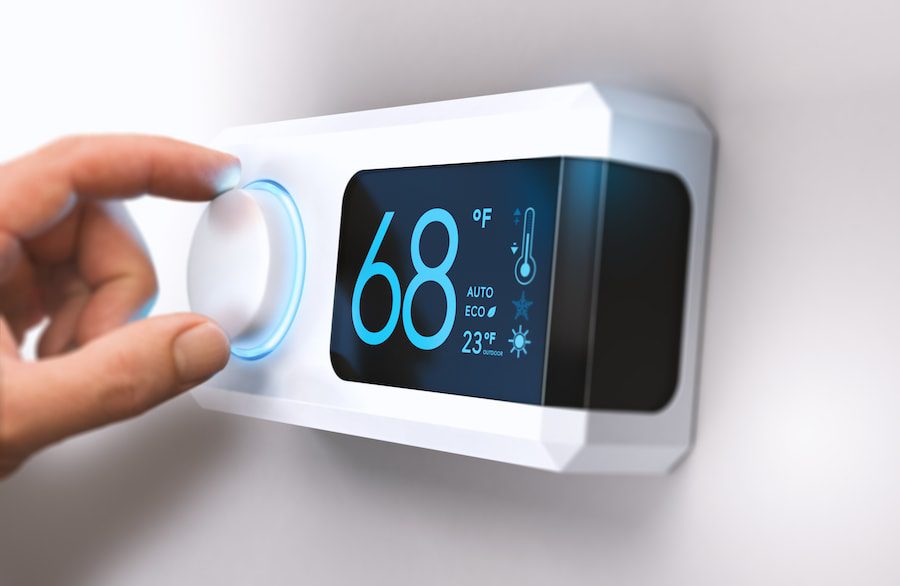When the house won’t cool down on a hot day or warm-up on a cold night we often blame our HVAC system. However, the problem can also start on a much smaller scale, the thermostat. Here we discuss how to tell if your home thermostat is broken with simple signs like a lack of power or response to your commands.
How do you Troubleshoot a Broken Thermostat?
Signs of a Bad Thermostat
There are some sure signs that your thermostat isn’t working properly. If the display doesn’t light up and is unresponsive, your thermostat may be broken or need new batteries. If you replace the batteries and the display is still unresponsive, something else is causing the issue. Other symptoms of a bad thermostat include:
- AC/heat won’t turn on
- AC or heater won’t shut off and runs constantly
- The temperature of your rooms doesn’t match your settings
Check the Settings
Before attempting to fix anything, check to make sure that the problem isn’t because of a programming error. If you visit the manufacturer’s website, you should be able to find a free digital copy of the instruction manual.
That being said, here are some of the most common troubleshooting errors across all brands of digital thermostats:
- If you’re using a heat pump, make sure that it’s set to heating mode. As simple as it sounds, it’s easily forgotten.
- Check that the thermostat is set to “auto” instead of “fan mode.” Fan mode means that the blower fan will continually blow regardless if the furnace is generating heated air. That could explain why it feels like cold air is coming out of your vents.
- The “hold” setting is used to lock the temperature in place, in the event that you’re trying to use the thermostat outside of its normal programmed settings. Whether you’re forgetting to use the hold setting or if you’ve forgotten to undo it, it can cause some confusion in operating the thermostat.
Inspect the Thermostat
If everything is fine with the programming but you’re still having issues, it could be time to inspect the thermostat:
- Programmable thermostats use batteries to save schedules and perform other functions. Try replacing the batteries.
- Thermostat readings may become inaccurate if the sensors collect dust or dirt. Gently wipe them off and see if performance improves.
- Perhaps your thermostat is tripping the circuit breaker for some reason. Check the circuit panel to find out.
If none of the above helps, then the thermostat problem might be with the wiring. We don’t suggest trying to fix this on your own, as working with electricity can always be dangerous.
How to Test Your Furnace Thermostat
Our step-by-step guide shows you how to tell if your home thermostat is bad with some simple tests.
Step 1: Reset the thermostat lower or higher
Check to see if the furnace or air conditioner turns on if you set the thermostat 5 degrees higher or lower than normal.
Step 2: Make sure the thermostat is ON
As basic as this sounds, buttons are mistakenly pushed all the time. Make sure the thermostat is on and double-check that your HEAT or COOL temperature setting is selected.
Step 3: Check the wiring
Turn the thermostat’s breaker off. Open the thermostat cover and make sure all wiring is properly attached and screws are tight.
Step 4: Turn the breaker back on
Observe if the thermostat turns on and functions properly after turning the breaker back on. If the thermostat doesn’t turn on or appears faulty, retest by turning the breaker on and off again.
Step 5: Reexamine wires
Make sure the breaker is off and examine the thermostat wires one more time. Locate red and green wires to turn on the AC and red and white wires to turn on the furnace.
Step 6: Wrap wires together
Remove either the AC wires or furnace wires from their port and wrap them around each other. Turn the breaker back on. If the AC or heat turns on, it’s likely a sign of a broken thermostat.
The Benefits of Thermostat Upgrades
Once you know how to tell if your home thermostat isn’t working properly, it’s time to install a new thermostat. A thermostat upgrade provides households with many valuable advantages:
- Improved temperature control with precision calibration
- Better energy efficiency with proper control over the HVAC system
- Less wear and tear to HVAC equipment
- Lower energy bills due to less energy waste
- Gain scheduling capabilities when you upgrade from a manual to a programmable or smart thermostat
- A thermostat with more user-friendly features than outdated models
Keep In Mind
Thermostats are not one size fits all. You need a new thermostat compatible with the type of heating and cooling equipment in your home. If you’re upgrading, it makes sense to upgrade comfort and control as well. The right thermostat selection delivers both, however, it’s difficult to tell sometimes which model is best for your home. Let the Omaha HVAC experts at Air Care Heating and Air help you choose the best thermostat for your home.
Additional Reading: Smart Thermostats – Energy Star
Air Care Heating and Air Conditioning – Residential & Commercial HVAC Services in Omaha & Council Bluffs
Air Care Heating and Air Conditioning is a full-service HVAC company located in Council Bluffs & Omaha. We know how important well-functioning heating, ventilation, and air conditioning systems are to your home or business, especially living in the Midwest. No matter what your heating and cooling needs, we provide a variety of heating and cooling HVAC services committed to exceeding your expectations with 100% customer satisfaction. Contact us today for your routine maintenance service, repairs, or installation requests -and let us show you the difference.

